Important AFRICAN American BLACK Modern Abstract Painting, DeShawn DUMAS'17

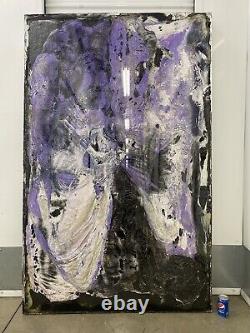
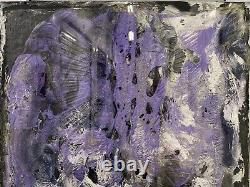
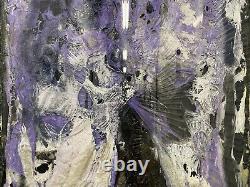

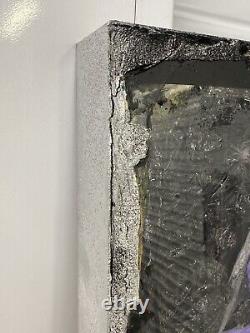




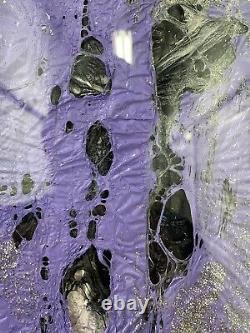
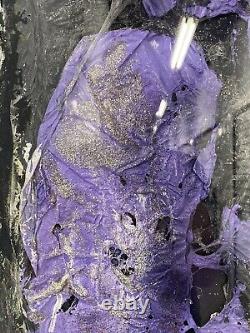
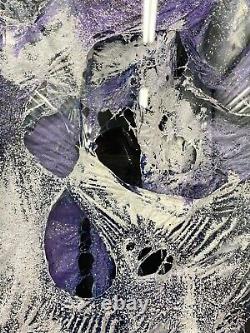
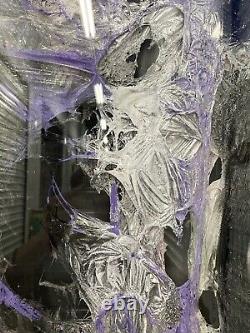

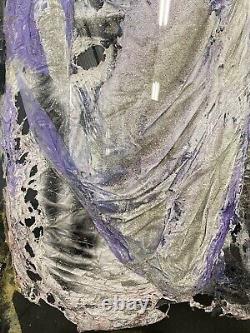

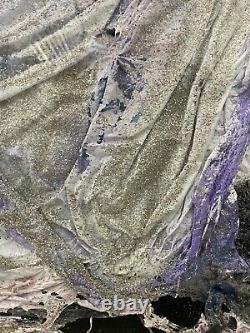
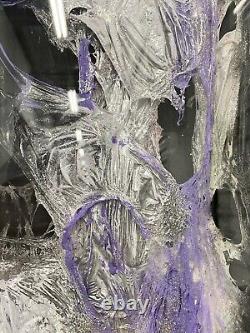
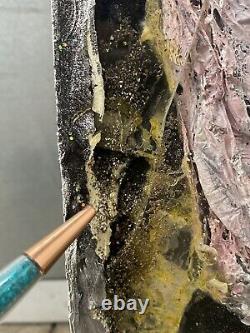

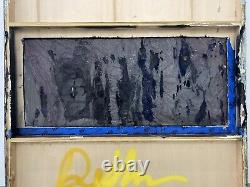
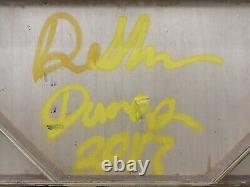
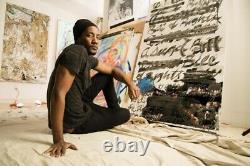

This is a profoundly expressive, visually striking and Important AFRICAN American BLACK Modern Abstract Mixed Media Painting, comprised of Laserprint Foil, Thermoplastic, Plexiglass, and Spray Paint, by the groundbreaking Brooklyn, New York Neo-Expressionist artist, DeShawn Dumas b. This artwork appears to be untitled and was very likely exhibited at the Museum of the African Diaspora (MoAD) for the celebrated 2019 solo exhibition of works by DeShawn Dumas, titled Against the End of History. This mesmeric and ethereal artwork incorporates multiple textures, materials, and colorful hues, to create a vivid and otherworldly tableau, reminiscent of some far away cosmic galaxy. This is a monumental and largescale artwork, at approximately 42 3/8 inches wide x 67 1/2 inches tall x 2 1/2 inches deep over 3 1/2 x 5 1/2 feet! Signed and dated: "DeShawn Dumas 2017" on the verso of the artwork.
Good overall condition for age and storage, with some hairline cracks and missing bits of Plexiglass along the edges of the artwork, which may actually be an intentional visual effect by the artist please see photos. Dumas is currently represented by the prestigious Ethan Cohen Gallery of New York City, and a very large-scale artwork by this artist would cost an enormous sum if you were to acquire it directly from this gallery. Dumas has been exhibited at the Studio Museum in Harlem, New York, the Museum of the African Diaspora (MoAD), San Francisco, California, and his artworks are held in some of the most prestigious and discerning private collections nationwide. If you like what you see, I encourage you to make an Offer. Please check out my other listings for more wonderful and unique artworks!
The ballistic monochromes of DeShawn Dumas reveal invisible forms of power and domination while challenging the anti-representational history of 20th century monochromatic painting. These conceptual works use violent methods of repetitive dishonor: burning, tearing, shooting, and smashing laminated glass panels as metaphor for the afterlives of slavery, if not the crises of the 21st century.
As the artist states himself: Western democracy has proven unable or unwilling to form an ethical, humane and inclusive society beyond the spectacle of screen culture and vapid consumerism. Dumas' art like the spectacle itself works precisely at the level of subjectivity. The spectacle packages the consumption of violence in ways which divorce domination and suffering from ethical considerations, historical understanding and political contextualization.To the contrary, Dumas explains my work concerns social death, particularly all those who lack the economic power, social visibility, lethal and ideological force to defend against the nightmare that is Western civilization. Born in 1983, in Elkhart, Indiana. DeShawn Dumas materializes wall works from various remnants of "heavy industry": chain link fences, steel frames, spray paint, plexiglass... Deeply inspired by the energy, the works are meant to move the viewer. As the artist puts it himself, When you stand in front of my works, I want you to have a powerful sensation.
I want you to feel a presence, almost as if a person was looking back at you. Lives and works in Brooklyn, New York. DeShawn's research centers whiteness as a militarized socio-economic order and psychodermatological frame for constructions of personhood and subjective experience.
His interests include aesthetics, political ontology, climate ecology and the future of policing. A contemporary conceptual painter and Visiting Faculty at San Francisco Art Institute, He received a Master of Arts degree in Fine Art and the History of Art and Design from the Pratt Institute. The World isn't a Monochrome: In the Studio with DeShawn Dumas. On the cusp of his debut solo exhibition at Janet Kurnatowksi Gallery in Brooklyn, DeShawn Dumas discusses his love of unconventional materials, romanticism versus political conviction, and. The importance of personal symbolism in painting. This past Sunday I met DeShawn Dumas, an artist who lives in Clinton Hill, Brooklyn. The dreary day had no impact on his upbeat manner as we walked toward his studio on Flushing Avenue. After he stopped me from entering oncoming traffic, he walked on the more dangerous side of the sidewalk [directly next to the street], because "that's how my mother raised me, " he said with a smile.Arriving in one piece, I sat down in a chair upholstered with hot pink chiffon facing two of his newest paintings. Dumas's diamond-shaped abstract works present the viewer with lofty concepts rooted firmly in both historical materialism and art historical interests. The initial surface of his paintings is composed of translucent scrims of chiffon, fiberglass window screens, geometric pieces of steel, and brightly colored layers of vinyl. These banal and industrial materials are suspended above a canvas support. It is on this foundational (canvas) substratum that Dumas engages in a ritualistic application of socio-historical substances: flour, coffee grinds, sugar, and pages from the King James Bible.
Formally speaking, Dumas's paintings or self-described "vehicles" emphasize the flatness of the picture plane, while still asserting the sculptural concreteness of these visual objects. In a way Dumas's vehicles reference polygon modalities of Constructivist painting and the architectonic qualities of Minimalism.
However, due to the use of translucent material, seemingly flat areas of color eventually permit the viewer's gaze to pass into the depths of these wall works. Dumas turned to art after realizing that a career in education would not give him the autonomy he sought.
Never having painted before, he entered the BA program at Indiana University and was accepted into their more challenging BFA program just one semester later. It was not long, however, before Dumas again realized that his interests and his studies did not align. Indiana University's traditional program taught Dumas invaluable lessons about composition, line, color and other traditional artistic skills but he learned very little about ways to incorporate his experiences into art beyond representational mimesis. Explaining why Henry Ossawa Tanner's painting. (1898) struck him, Dumas says: The angel was all light, there was no figuration-the first paintings I made were like that.
I painted my mom and my nephew with this Renaissance pose and this glowing light. But I was dissatisfied; it didn't do anything for me. I guess it didn't have a concreteness for me. This tension between art and reality started to crystallize at a group exhibition featuring his professors' work. The reception took place the same week Hurricane Katrina came ashore. We didn't talk about Katrina at all, we just talked about the art. This was weird because I was constantly being shown images of a devastated citizenry on TV, and this disconnect provided insight into the function of the gallery space as a'non-space' which seems to exist in a type of vacuum. Thereafter, Dumas began to incorporate non-art materials like coffee, sand, and flour into his art; going against his professor's (good-natured) wishes- "you can't use sand, it's not archival" was a typical rebuttal.But traditional paints and brushes didn't let Dumas connect with the visceral sensations of lived experience. At the time he was unaware of artists like Anselm Kiefer, who he came across in 2006. That's when I became excited about art, I understood that there was art outside of romantic rendering; I saw that the trauma of existence could be aestheticized.
The final break with his traditional art education arose around the onset of the Israeli/Lebanon war in 2006. I was following the underground media that was covering it, but that was it, nowhere else was there even talk of it. I thought-if human life can be destroyed, and be destroyed in a way that's unnoticed, why would I put so much time and be so careful making a painting? So I started burning my paintings and making these charred landscapes. This shift toward non-traditional art materials and politically motivated abstraction kept growing.Luckily for him, from 2008 to 2010 Marco the super of his Washington Heights apartment building allowed him to use the basement as a studio. For two years he didn't touch a brush or use paint.
Instead, I would just use fire and my hands. After entering Pratt's MFA program in 2010 his work rapidly shifted from semester to semester. Although Dumas had gradually become comfortable with allowing his personal concerns and frames of reference to enter the work in oblique ways, he says, I still had not liberated myself from a prescribed or tasteful use of color and the tradition of art history. He recalls the time when he avoided the bright, saturated colors found in his current paintings, opting instead for a more meditative palette. Even though he speaks fondly of the calming and alchemic process of making monochrome oil paintings, he wasn't sure what he was offering the viewer, and how honest he was being about his own aesthetic and psychic sensibilities. The world isn't a monochrome landscape, at least not New York City, not for me. The world isn't this meditative place. It's liminal, flickering, moving, hard, sometimes soft, sometimes giving, it's a complex and intense situation. So, at a certain point I felt that my subtle oil paintings were feigned, a nostalgic homage of how I envision the world or art or some metaphysical space to be. But my world has never been soothing and subtle and I doubt the world has ever been like the paintings I use to make. You read what Kandinsky says in. Concerning the Spiritual in Art.'Our minds, which are even now only just awakening after years of materialism, are infected with the despair of unbelief, of lack of purpose and ideal. So this was written in the early 20th century in Moscow, I mean, what would Kandinsky write about materialism in 21st century Dubai? My return to bright colors was the realization that I do like dramatic colors, whether it's the electric glow of Times Square or the flamingo halo of a setting sun; I do see bright colors and I'm going to use bright colors and not feel that only unsophisticated people use bright colors. You know, Jeff Koons was someone I never let myself like- but, I do, I actually like him. I went to his show that just opened and it's amazing. Especially the steel balloon sculptures. They're huge and you just walk around them.Even though you realize they're sort of absurd things-verisimilitudes of balloons, but you also feel you're looking at the curves of a body. You're looking through these cavities and negative spaces and at your reflection.
I really had to understand how to fail and how to laugh at myself and get over myself. These realizations came when I stopped looking at and judging what was outside of me and directed my gaze inward. This was an excoriating process that revealed a side of me that is definitely profane, you know, that definitely likes the shiny and superficial. I had to develop the ability to challenge my convictions. Essentially, I had to overcome my fear of the world and let my enthusiasm for the moment shine through.A turning point for the artist came when he started veiling silk over burnt canvases. Dumas's use of the veil strains the eye and forces it to slow down as it searches to see what's underneath the surface. This gives his static objects a sense of duration through time. The Meek Shall Inherit the Earth (as they are buried beneath it). (2013), obfuscated Bible passages seem to emerge from a gaseous atmosphere.
The pages are not randomly selected. Raised Pentecostal, Dumas was enthralled by the dramatic intonation of his Uncle's sermons, which often revolved around God's convent with man and potential damnation or salvation.
As a child I was obsessed with the end-time or eschatological prophecies and perplexed when I attempted to imagine the finality of infinity and the contradictions of God's vengeance and God's unconditional love. Turning the square canvas into a diamond imparts a sense of rotation that is grounded in this early preoccupation with infinity.
The diamond becomes Dumas's graphic symbol for the universe and the ceaseless flux of existence. " Dumas also says, "I want my vehicles to have an ontology of their own, a type of binary presence that conveys contradictions simultaneously: dread, attraction, mystery and clarity. Or what the German theologian Rudolph Otto calls a numinous consciousness. Dumas's process and output oscillates between the abstract and the profane.
His philosophical thoughts don't interrupt his experience of reality, and his paintings reflect a balance between these dualities. Before my studio visit concluded we had a chance to talk about LaToya Ruby Frazier, an artist Dumas admires for her ability to mix strong aesthetics with political and social concerns. She is a contemporary artist I like a lot; her work is very personal and open. I think her work is an exceptional form of social practice.Maybe one day I will do something that is more socially relative, but for now I'm excited and comfortable about my art practice. The great thing about aesthetics is that it amounts to your subjectivity confronting another person's subjectivity. And you can sort of think whatever you want.
No one can say if you are wrong or right. On view May 31 through June 30 at Janet Kurnatowski Gallery, 205 Norman Avenue, Brooklyn, NY, 11222. DeShawn Dumas prefers materials that possess troubled pasts in addition to their aesthetic qualities. Janet Kurnatowski Gallery, Greenpoint May 31 - July 14, 2013. Ike others working at the boundaries of their discipline, DeShawn Dumas often finds inherited categories inapt. His paintings include little paint; he plays with the plane.He prefers materials that possess troubled pasts in addition to their aesthetic qualities. From even a short distance, small print disappears behind screens. Take it as an invitation. Dumas has a BFA from Indiana University, an MFA from Pratt, and is a year away from earning a Master's of Science in Critical Theory and Art History at Pratt.
I sat down with Dumas at Janet Kurnatowski Gallery in Brooklyn on the heels of his extended solo exhibition. How do you relate to this collection? It's the most cohesive endeavor I've ever completed.I'm not a unified individual. I'm made up of disparate interests, ideologies, perspectives.
So, even though they are similar in shape, scale, size, and material, they are extremely diverse. I think one of the most important tasks facing the artist is to investigate the self and see what's really in there; to reify the hidden corners of your personality. For me, that has meant realizing the diversity within myself. Comprehending this internal difference can create a unity that doesn't demand harmony, but is complex enough to encapsulate the various aspects of my psyche. That's the sort of cohesion this exhibition has.
Do you refer to these pieces as paintings, vehicles, or both? Initially, I referred to them as a form of painting, painting in parentheses. As time went on and I made more, and I thought about my intentions and the historical connections that I was interested in, I came up with the term vehicles.I like vehicles as a term distinct from painting because even though they deal with the principles of painting - line, transparency, opacity, color, shape - their intention is connected to the Vedic tradition, a tradition that I know very little about but seems to know about me. Sri Yantras are graphic symbols for the universe that were constructed for meditative purposes, to get the individual in touch with the macro and micro. I was initially drawn to them because of their rotation. They have this movement in them that I was captivated by; I would stare at the computer screen for long periods of time, entranced.
Wow, this is better than any sort of visual experience I have when I go to museums. I also have a regard for manual labor and art's relationship to the machine, which, in some ways, aligns my work with Russian Constructivists who hailed the death of art and its rebirth as industry. Constructivist art had a utilitarian component; it was a movement that engaged the external, or what lies outside of fine art. That's one historical precedent I'm engaging when I get these aluminum and galvanized-steel frames manufactured. I took some of the frames to an automotive shop to get painted. So, I put painting in parentheses because I'm trying to deemphasize painting.It sounds negative but by deemphasizing it I'm really trying to extend it. To extend something is essentially to go beyond it. My interest in car culture and my spiritual susceptibilities are present in my work. I'm interested in these as tools that can be used to focus attention. Vehicle seemed like a good word to suggest my intentions.
So they are intended then, in one way or another, to move the viewer? That's something that I feel is really important for art. I think people come to art for different reasons. Some come to art for a sort of ritualistic self-representation of their cultured identity. I believe others come to art for an experience, for something they can use. I want to give those people something emotional, something seductive, something fraught with tension, something pleasurable. So, yeah, the idea that the viewer is moved or invigorated is paramount for me. I think art is about energy. It's not about the didactic, it's not all about tradition, it's not about beauty, and it's not about taste. When you stand in front of my works, I want you to have a powerful sensation. I don't want my paintings to be rarefied. Lists spray paint and automotive paint. NutraSweet and The New Jim Crow #1. There is no paint in. The Meek Shall Inherit the Earth. The Unity of the Spectacle.Why do you locate yourself in the milieu of painting? The objects that I'm making are in conversation with painting, those formal principles that have concerned painting. But, most importantly, with painting there is an encounter with the wall and the object on the wall. There's a sensation that this thing is outside of normal relationships, normal reality; it's more in your mind. I think that's why I'm drawn to painting, and I think that's the ultimate power of painting, or the resilience of painting.
Reality can be so mundane. Materials usually dictate the way art looks. If you go back to the Renaissance, people painted in tempera. When oil paint came out, it had this new ability to convey a vividness and shine that you just couldn't get with tempera. I believe vinyl and fiberglass screens allow for a new form of expression that you can't get with oil paint or acrylic. With whom are you in dialogue? I'm always trying to get information into my work. The information in my work is intransitive, like an intransitive verb - an action that has no object. The other two movements that I'm always coming back to are Minimalism and Pop Art. Minimalism engaged with industry, getting things fabricated, taking the artist's hand out of the production of art, while still making reference to the institution or structure that made the work possible. From Pop Art, I draw ideas about the profane, the graphic, and the magic, grace, and glamour of the commodity. These are things my work engages.Are there any artists with whom you identify? Sam Gilliam is somebody who changed my concept of art. I saw a retrospective of his at the Corcoran in twenty-o-six and he was doing these draped fabrics. These draped, tie-die fabrics hovered over a room with this weightless quality; and then you had the shadows these objects created.
They had a theatricality to them that I appreciated. Steve Parrino and David Hammons as well. CB: When did you make the paintings/vehicles for your exhibition. They diverged immensely from the work that I was doing last March, last January, and last May. My turning point came in the summer of twenty-twelve, when I decided to make a piece that I didn't like.I'm gonna make a piece that's not me. And that was actually the piece that was exhibited in Chelsea last December. The piece was green; therefore, I didn't like it. I had never used green in any of my work. But it was an interesting painting.
Because I separated myself from it at the very beginning, I was able to go beyond myself. That piece did not have the space that these have, but it did approach the overlaid quality these have, where geometric qualities exist alongside the organic or bodily qualities of the drape and fold. That piece brought me here. Can you describe the process of making a piece?
It's usually a lot of carrying shit. You know, getting coffee grinds from Starbucks, going to the grocery store to get flour and sugar, going to the hardware store to get nails and staples, or wood and steel supports, or chains. Then, I'll go into the city to get vinyl off Canal Street and up to the fashion district to get fabric. I like working off hours, when it's not nine-to-five.
During the day, I feel like there are so many other consciousnesses around, awake, hustling, bustling, that I can't get beyond that energy. I like working when people are asleep, or in leisure. Since these are really structured paintings, a certain amount of work has to be completed before another aspect of the painting can be started. I'll stretch the canvas over the frame, which will ultimately be the substratum of the piece, and things will float above it.I usually place a reflective surface over that, which replicates the white of the gesso. From there, it just depends. It's a lot of trial and error, actually.
I'm hoping that as I move forward I'll be able to lessen my mistakes, my do-overs, my trips to the store. How flexible are you when you're working, as regards whatever you have prefigured? Do you try to stick to your original idea for a piece? I let the mistakes or the chance occurrences that happen in the production of my art guide the production of my art. Paintings don't work when I stick to my intentions. It's always letting go, giving up, losing, failing. There is a lot of failure in all of these. But, failure usually creates something and the destruction of my idea usually creates something else.I've painted over and destroyed a lot of paintings. I never really feel close to anything, especially in my work.
It's easy for me to let go now that I understand there's nothing to hold on to. How do the four smaller pieces fit into the show?
They were made with less forethought and less planning. Because they're smaller, I was able to make something with less detail, so they are very direct. But they're connected to what I'm doing with the larger pieces; in fact, they might be a better example of what I'm attempting to do, as far as bringing different materials and different histories into my work. Are ready-made panels that I doused in packets of NutraSweet, burned with a torch, and then wrapped in organza fabric, which has these lines. This lined pattern has been a mainstay for modernism, whether it be Frank Stella, Morris Louis, or any number of modernist painters. But I wanted to point out an evocation of bars with my title. With the privatization of prisons, starting in the 1980s, incarceration became an avenue to make profits. Aspartame was approved by the FDA in 1981. It had been banned for two decades because of the harm it caused rats. It has been linked to high cancer and obesity rates, and it's used in a lot of diet products. NutraSweet and The New Jim Crow. How do you think living in New York City has affected your art? I realized that layers are a way to create space while sitting in a Starbucks in Washington Heights, near my home at the time.I was sitting in Starbucks, looking out the window. They had their transparent logo on the glass, so I was seeing through the logo, and then I was seeing people walk by me, and then I would see people walk by them going the other direction; then I could see the street, and then I would see other stuff going on. I don't think I would have learned the intensity that overlapping gives without coming to New York.
Would you characterize this as a pivotal period in your own artistic development? I wouldn't say this is a climax because it's lifelong.For me, it's about trying to understand the stories I tell myself to rationalize what I do, and the stories that society tells itself to rationalize what it does or has done. My work is always going to be a dual critique: of myself first, and whatever surrounds me second. Do you consider yourself a professional artist?
What does it mean to be a professional? If it means to make a living off what you do, then no, I'm not a professional. But, if you consider a professional as someone with a certain attitude, a certain aptitude - I think what I'm doing will have to be considered historically at a certain point.
I'm deeply engaged in the system or tradition of painting, but I'm recoding it for the 21st century. Created as tribute, DeShawn Dumas' Ballistic Testimonies presents a memorial to the here and now, addressing some of the perils and complexities of being in contemporary America. Part of an ongoing series started in 2017, the installation consists of totemic glass paintings riddled by a constellation of bullet holes, created by the brute velocity of. 40 caliber bullets fired from standard issue police sidearm. Recalibrating the objecthood of minimalist sculpture, the works suggest the universal fear of being mortally wounded, staging the obscene jouissance (or'enjoyment' in English) of a materialist and spiritually anemic society. Intended to be both poetic and potentially polemical, Ballistic Testimonies provides a literal point of reflection for the viewers, regardless of whether they are targets of societal violence or complicit of it. 1985, Elkhart, IN is represented by Ethan Cohen Fine Arts (New York, NY). Candidate in Culture & Theory at the University of California Irvine, he earned his MA/MFA from Pratt Institute; and is currently an AICAD Postgraduate Teaching Fellow at the San Francisco Art Institute. This fall he will be in solo exhibition at the Museum of the African Diaspora in San Francisco. Selected exhibitions include Kravets/Wehby Gallery (New York, NY), Janet Kurnatowski Gallery (Brooklyn, NY), Harvey B. Gantt Center for African American Arts and Culture (Charlotte, NC), and the Dukley Art Center (Kotor, Montenegro).Holocene Extinction: DeShawn Dumas at Ethan Cohen. DeShawn Dumas: Holocene Extinction at. June 22 to July 24, 2017 291 West 19th Street, between 7th and 8th avenues New York City.
Painters work within the conventions of their times, by which I do not just mean within a style or an aesthetic: they are bounded within modes of thinking and feeling that are so pervasive as to be virtually invisible. Some artists embrace these constraints or strain against them, while others both use and rebel against what is given. DeShawn Dumas, in his exhibition.
Takes a number of the conventions of painting today, pushes them, and in the process makes something urgent. These include provocative use of materials, play of one visual system against another, and the presence of painterly gesture. But this work reaches beyond the formal into a zone of emotion and immersion that itself becomes a medium conveying the personal, the political, and the transcendent, and back again in a continuous loop of reference and contingency.At the same time that he presents us with this multivalent psychic spectacle, Dumas seals it within glass or thermoplastic, surfaces that are occasionally broken. The transparent sheets both encase the works and carry paint on their reverse sides, in a contemporary version of traditional glass painting. The effect is to dramatize the artist's and the viewer's relationship to feeling: at once impassioned and distanced. In this exhibition Dumas presents work in multiple modes, demonstrating painting's capacity to unsettle itself, while working both within and beyond its known dimensions. Most striking are the artist's large-scale paintings that layer reflective Mylar that has been distressed until it is full of holes and fissures.
Enhanced with spray paint, these works are psychedelic fantasias, gorgeous and dangerous in their dissolution. Once Upon the Amazon (Ayahuasca). (2017, all works in show), in a profusion of reflective greens and golds, evokes both the growing world and the inner space of drug-aided visions. The same spirit prevails in. A work dominated by depths of blues and green.
Particularly stirring among the three Mylar works is. Hold in Mind (Whiteness and Western Transcendence - apolitical, ahistorical, postracial utopia). In chartreuse, scarlet, and powder blue, it gives us a glimpse of the sublime and simultaneously questions an aesthetic convention left untouched by a larger social awareness. The painting's title, as in the case of each of Dumas's works, is essential in connecting us to the artist's poetic intent.Alerts us to the allusive role that language plays here, and refers to the current geological epoch marked by homo sapiens. Included in the effects are global climate change and the extinction of 30-50% of all species by mid-century. But for Dumas, the question of extinction also points to the present danger of violence against African-Americans. This is made immediate and personal in the painting.
Frames of War frameworks wherein certain lives are regarded as worthy of protection while others are not, precisely because they are not quite lives. The painting is part of an installation that includes drawing on the wall and a small painting on the floor with shattered glass titled. The paintings, along with a bouquet of purple flowers, comprise a memorial to the artist's half-brother, who died in a police shooting and whose photograph leans against the larger work. Two other Black Mirror paintings combine expressionist painting with a surface of shattered glass.
Is a beautiful work that recalls this repressive law enforcement policy. But of the smaller works in the show. Untitled (and we hate the po-po want to kill us in the street for show). It is a bright red wound, with dripping paint the color of dried blood that stains the broken glass covering the surface of the painting. The most cryptic work of the show is a large horizontal painting.Neoliberal Waltz He dreamed that the four-leggeds were going back into the earth and that a strange race had woven a spider's web all around the Lakotas. And he said: When this happens, you shall live in square gray houses, in a barren land, and beside those square gray houses you shall starve. Incorporating the words of Black Elk, the Ogala Dakota medicine man and visionary teacher, the title connects genocide and unrestrained capitalism, embodied in the symbolic nexus of a fragmented gestural ground and a geometric net. MoAD Emerging Artists presents DeShawn Dumas. Museum of the African Diaspora.
Against the End of History. A solo exhibition by DeShawn Dumas presents painting, video, and the artist's self-described ballistic monochromes, in a multimedia installation that situates the sacred within the political. In this exhibition, Dumas counters the assertion of liberal democracy as the final form of human government and defender of human dignity as established by American political scientist Francis Fukuyama in his 1989 essay The End of History?
Dumas deploys the visual languages of abstraction and minimalism to explore the psychic and historical afterlives of slavery, the increasing cultural predominance of militarized policing and the ecological catastrophe of climate change. Inhabiting the terrors of a past, not yet past. Offers a space to contemplate the struggle for future(s) worth living. Ethan Cohen New York is pleased to present Holocene Extinction on view June 22 through July 24, 2017. The exhibition takes its title from what scientists call the sixth great mass extinction. Scientists estimate as many as 30 to 50 percent of all species possibly heading toward extinction by mid-century. Unlike past mass extinctions, caused by events like asteroid strikes, volcanic eruptions, and natural climate shifts, the current crisis is almost entirely caused by capitalist civilization. In the broadest terms, Dumas addresses the seduction of the Western spectacle and our collective dissociation from what Joseph Beuys called the death zone toward which today's society is rushing with great speed. In an installation featuring several mixed-media paintings, DeShawn Dumas continues his inquiry into irreconcilable difference. While Dumas' prior mixed media paintings highlighted the tension between written language and the gestural mark his current exhibition makes reference to the politics of desire, ecological catastrophe, geological stratification, consumer telecommunication devices, and the architectonics of the city.Dumas revisits the historical gulf between the illusionistic or pictorial space of American post-war abstraction and the theatrical literalism of Minimalist sculpture - rehashing Michael Fried's famous defense of modernist painting. In Art and Objecthood Fried advocated, . That there was a war going on between theatre and modernist painting. Of experience, conviction and sensibility.
" Fried continued, "what I have been calling theater has chiefly made itself felt as the need to establish a drastically different relationship to its audience. Similarly, Dumas uses reflective industrial materials, the physicality of the support, and processes of burning and puncturing in attempts to suggest a hallucinatory experience. These enchanting vitrine-like paintings bear witness to a culture of inhumanity and ephemeral fantasy. An impossible suspension occurs where what appear to be glittering clouds of pixie-molecules and synaptic webs (a metaphor for magical thinking) obscure ritualistic acts of violence. Dumas' theater offers a space of candy-coated terror.
For the artist the Neoliberal era and its plausible transition may become the nightmare from which we are all trying to awaken. Holocene Extinction, Ethan Cohen Gallery. Darkest Before Dawn: Art in a Time of Uncertainty, Ethan Cohen Gallery. Orphans of Painting II, Ethan Cohen Gallery. Fears of Art, Ethan Cohen Gallery.
Talent Show, Ethan Cohen Gallery. Orphans of Painting, Ethan Cohen Gallery. Art Remixed, Ethan Cohen Gallery.
Ethan Cohen New York at VOLTA14, Ethan Cohen Gallery. Ethan Cohen New York at Miami 2017, Ethan Cohen Gallery.
Ethan Cohen New York at CONTEXT Art Miami 2015, Ethan Cohen Gallery.

